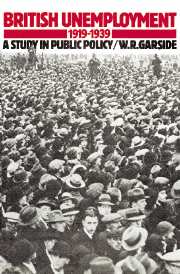Book contents
- Frontmatter
- Contents
- List of tables
- Preface
- Acknowledgements
- PART I INTRODUCTION
- 1 The nature, causes and dimensions of interwar unemployment
- PART II THE LABOUR MARKET UNDER STRAIN
- PART III THE INTERNATIONAL CONTEXT
- PART IV STRUCTURAL UNEMPLOYMENT, INDUSTRY AND THE REGIONS
- PART V MACROECONOMIC POLICY OPTIONS: THEORY AND PRACTICE
- Bibliography
- Index
1 - The nature, causes and dimensions of interwar unemployment
Published online by Cambridge University Press: 21 September 2009
- Frontmatter
- Contents
- List of tables
- Preface
- Acknowledgements
- PART I INTRODUCTION
- 1 The nature, causes and dimensions of interwar unemployment
- PART II THE LABOUR MARKET UNDER STRAIN
- PART III THE INTERNATIONAL CONTEXT
- PART IV STRUCTURAL UNEMPLOYMENT, INDUSTRY AND THE REGIONS
- PART V MACROECONOMIC POLICY OPTIONS: THEORY AND PRACTICE
- Bibliography
- Index
Summary
AGGREGATE UNEMPLOYMENT BETWEEN THE WARS
Ministry of Labour statistics relating to the working of the unemployment insurance scheme provide the basic source of information about the volume and nature of interwar unemployment. The number of unemployment books issued each July to those persons within the scheme enabled the Ministry from 1911 to calculate the total number of insured persons and to classify them by industry, region and sex. In order to claim benefit, insured persons had to lodge their unemployment books at an Employment Exchange; it was from the number of such books lodged combined with the numbers insured and unemployed that a monthly and yearly unemployment rate was derived. Until 1926, an alternative unemployment percentage was available from the monthly returns of a select group of trade unions which paid out-of-work benefit to their members.
Although the scope and validity of these two sources of unemployment data have been exhaustively discussed elsewhere, a number of cautionary remarks are in order if we are to gain a proper perspective on the interwar period. The trade union returns, available in continuous form since 1888, cannot be regarded as an adequate indicator of unemployment amongst either the total working population, industrial manual workers or even all trade unionists.
- Type
- Chapter
- Information
- British Unemployment 1919–1939A Study in Public Policy, pp. 3 - 28Publisher: Cambridge University PressPrint publication year: 1990



